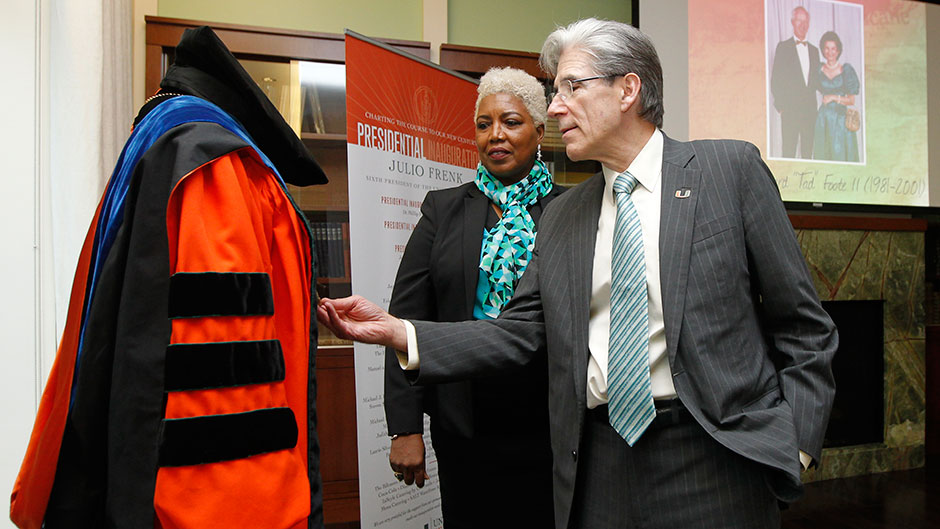The student-athlete and the history professor were both unknowing University of Miami pioneers. Golfer Terry Williams Munz had no idea she was the first woman in the U.S. awarded an athletic scholarship when, in 1973, she accepted UM’s enticement to play golf while earning her degree.
“All I knew was that the University of Miami was really dedicated to building women’s athletics,” Munz, a member of the 1977 championship golf team, recalled.
And Professor Emeritus Whittington Johnson didn’t know he was breaking a color barrier when he began teaching black history in 1970. Yet his was the first black face on the UM faculty. “It’s always been a welcoming place,” he said. “Next to marrying my wife, coming to the University of Miami was the best decision I ever made.”
Munz and Johnson were among the many “Firsts at UM” President Julio Frenk and UM Trustee Arva Moore Parks, a noted historian, author, and UM alumna, celebrated during a wide-ranging public conversation on Wednesday, just two days before the former Harvard dean’s official installation as UM’s sixth president since its 1925 founding.
Moderated by history Professor Donald Spivey at the Newman Alumni Center—the first LEED-certified building on the Coral Gables campus—their exploration of many of UM’s milestones was inspired by another writer, Frenk’s paternal grandmother, who fled the growing Nazi atrocities in 1930s Germany to begin life anew in Mexico, where her grandson was born, became a physician, and served as minister of health.
Over her extraordinary 106 years, Mariana Frenk-Westheim chronicled many of her first-time experiences in a book, Y mil adventuras, (a thousand adventures), which Frenk said impelled him to begin collecting his own “firsts” as a new member of the Hurricanes family.
“It’s been growing exponentially these last five and half months,” he told the audience of trustees, faculty, staff, students, alumni, and other community members who could fill countless pages with their own UM firsts.
Joan Clancey, the first woman admitted to the Rosenstiel School of Marine and Atmospheric Science, and Allan Herbert, who met the love of his life on campus, shared their remembrances of a time when female students had to adhere to strict curfews and were literally fenced into their dorms.
“Not just to keep the men from coming in, but to keep the women from coming out,” recalled Herbert, who with wife Patti made a landmark gift to the Wellness Center that now bears their name. “There was a tradition of women learning to become high-jumpers.”
“The men would jump the fence,” Clancey corrected. “Those were the days of panty raids. We had to wear skirts at all times—even to go downstairs to get the mail.”
Frenk’s appreciation for and knowledge of UM’s rich and colorful 91-year history also has grown exponentially since the August day he took the reins of the U
With Frenk asking the questions, and Parks, who just published George Merrick, Son of the South Wind, providing the answers, the duo discussed how just a month after the visionary founder of Coral Gables began selling lots for one of the first planned communities in America, he declared his intent to build a University of Miami in Coral Gables.
And as Frenk, the first Hispanic president of UM, marveled, even back then, Merrick realized the value of Miami and its namesake university as a bridge between North and South America.
That vision for a Pan American university, which Frenk intends to strengthen, was a thread throughout the conversation, which also touched on the University’s capacity to triumph over adversity; its many innovations and research discoveries; the influence World War II and the G.I. bill had on its growth; and the role athletics and athletic achievements have always played in student life.
“This may surprise some of you,” Frenk said. “But our first national championship was in the sport of polo in 1947.”
As he noted, the U would go on to win five national titles for women’s golf, four for baseball, two for women’s swimming and diving, one for men’s crew, and five for football.
Frenk also displayed his familiarity with UM’s charter, its early yearbooks, and the inauguration speeches of the four UM presidents who gave one. As Parks explained, when the devastating 1926 hurricane threatened the fledging U’s opening the following month, Bowman Foster Ashe moved from the role of executive director of the largely all-volunteer university to its first president and never gave an inaugural address.
In addition to Munz and Johnson, Ashe’s grandchildren sat in the audience. So, too, did Norman Kenyon, the first student president of the first class at the University’s medical school, which when it opened at the Biltmore Hotel, then a Veteran’s Administration hospital in 1952, was the first in the state.
“It’s astonishing,” said Kenyon, a surgeon who still works in the diabetes research lab of his daughter, UM’s vice provost for innovation, Norma Sue Kenyon. “Where the University has come from, and where it is going.”
To view historic photographs and other artifacts, visit the ground floor of the Newman Alumni Center. In addition, the Otto G. Richter Library is featuring the exhibit, “Pan American University: The Original Spirit of the U Lives On,” through the end of the summer.

